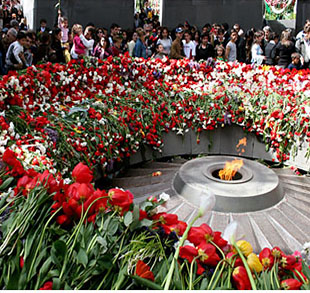
The Armenian Genocide
In late 1870s during one of Russian-Turkish wars the Treaty of San-Stefano was signed according to which Turkey was to undertake economic reforms in its areas populated by Armenians. Soon popularly known as the Young Turks, controlled the government of Turkey with leaders Mehmet Talaat, Ismail Enver, Ahmed Jemal as Ministers, assigned to military commands to carry out the Armenian Genocide extermination in three phases.
During the first phase, all the Armenian males of 15-45 ages were recruited to Army. The second phase was the slaughter of Armenian political, intellectual, cultural and military leaders. On April 24, 1915, in Constantinople 235 intellectuals were arrested and taken to prison; such famous Armenians as Siamanto, Grigor Zohrap, Ruben Sevak, Daniel Varuzhan and other progressive minded intellectuals turned into the victims of the Turkish sword. The third phase was the extermination of unprotected and peaceful Armenian population, the majority of who were women, elderly and children. Armenians were enforced either to denounce Christianity or be killed. (https://www.genocide-museum.am/eng/armenian_genocide.php )
According to the witnesses and international reporters over 1.5 million Armenians were killed in the Ottoman Turkish Empire and over 1 million became refugees.
The international community condemns the Armenian Genocide. Countries that have officially recognized it – Argentina, Belgium, Canada, Chile, Cyprus, France, Germany, Greece, Italy, Lebanon, Lithuania, The Netherlands, Poland, Russia, Slovakia, Sweden, Switzerland, Uruguay, Vatican City, Venezuela.
The Armenian Genocide memorial complex is Armenia's official memorial dedicated to the victims of the Armenian Genocide, built in 1967 on the hill of Tsitsernakaberd. Every year on April 24—the Armenian Genocide Remembrance Day—thousands of Armenians gather at the memorial to commemorate the victims of the genocide. The 44-meter stele symbolizes the national rebirth of Armenians. Twelve slabs are positioned in a circle, representing the 12 lost provinces in present day Turkey. In the center of the circle, at a depth of 1.5 meters, there is an eternal flame dedicated to the 1.5 million people killed during the Armenian Genocide.
The Armenian Genocide Museum-Institute opened its doors in 1995 on the occasion of the 80th anniversary of the genocide. The structure of the museum has followed a unique design. Since opening its doors, the museum has received tens of thousands of visitors including schoolchildren, college students and huge numbers of tourists from outside Armenia. Exceptional documents and pictures are being kept in the Museum about Genocide. (https://www.genocide-museum.am/eng/armenian_genocide.php )